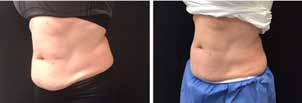
5 minute read
Beating The Winter Blues
Most areas in Europe and North America observe daylight saving time. Daylight saving time is often welcomed in spring, as it helps to extend daylight hours well into the evening, but few may welcome turning the clocks back in fall.
Coupled with the natural shortening of daylight hours as winter approaches, the end of DST facilitates a sudden shift in the ratio of sunlight to darkness. As autumn transforms into winter, the number of available hours of daylight slowly dwindles. Some areas of Alaska and Canada see only about three or four hours of daylight per day in the winter months. Conversely, those who live in Key West, Florida, the southernmost point of the contiguous United States, may enjoy around 10 hours of daylight. Fewer daylight hours can adversely affect mood and productivity. Seasonal Affective Disorder, often referred to as “SAD” or “the winter blues,” has been recognized and included in the Diagnostic and Statistical Manual for Mental Disorders. Clinicians say that, as days become short and dark, a predictable set of symptoms of SAD may emerge. Individuals with SAD may experience a host of symptoms, including difficulty waking in the morning; diminished energy levels; a tendency to eat more; an inability to concentrate; and depression.
The Cleveland Clinic advises that approximately half a million people in the United States suffer from winter SAD, while 10 to 20 percent may suffer from more mild forms of winter blues. The Canadian Mental Health Association
states that between 2 and 3 percent of Canadians will experience SAD in their lifetime. Another 15 percent will experience a mild form of SAD that leaves them only slightly depressed. Similar symptoms can occur for those people who live in cloudy regions or high latitudes.
Evidence strongly suggests SAD is linked to sunlight. This lack of sunlight may trigger production of melatonin in some individuals. Melatonin is a hormone made in the pineal gland that regulates sleep onset and sleeping patterns.
A combination of selfcare strategies as well as professional medical treatment may help those with winter blues or more severe SAD. The U.S. Department of Health and Human Services says that these strategies can help people coping with SAD. • Get out of the house into sunlight or brightly lit spaces early in the day when the sun is out.
•Increase time spent outdoors. Take a break midday and enjoy lunch outside or take a walk, even if it’s chilly.
• Try to spend time with other people and chat with friends and relatives.
• Avoid overloading on carbohydrates like cookies and candies.
• Talk to a doctor about using light therapy, which is the
first line of SAD treatment, according to the University of Maryland School of Medicine.
• Consider cognitive behavioral therapy or talk therapy with a licensed mental health provider. He or she also can make recommendations about the use of medication to alleviate symptoms if other treatments do not provide results.
There are many ways to mitigate the symptoms of winter blues.
Looking to Buy a Home? 2020 May Be Your Year
If buying a home is on your near-future to-do list, experts say that 2020 may be a good year to make it happen. Mortgage interest rates are near historic lows, providing you with the opportunity to finance a new home purchase at a much lower cost.
According to a new forecast from Freddie Mac, mortgage rates will stay in the 3-4 percent range for all of 2020 and 2021, giving prospective homeowners substantial time to plan their purchase. This, combined with modest inflation and a solid labor market, makes for good climate to buy a home with a fixed rate mortgage. For those who are already homeowners, refinancing now may be a good idea.
“For those serious about homeownership, today’s sub 4 percent mortgage rates should not be taken for granted,” says Freddie Mac chief economist, Sam Khater. “For comparative purposes, in 2000, rates averaged eight percent; and in the 80s, they spiked to 18.5 percent.”
Khater stresses that while mortgage rates are an essential factor to consider in the home-buying process, there are other important items to think about as well as you lay the groundwork for your purchase. These include getting a firm handle on your finances, knowing your credit score (and taking steps to boost it if necessary) and familiarizing yourself with down payment options. For more information and tools on home buying and homeownership, visit myhome. freddiemac.
Whether you are making the jump from renting to owning, or looking for a home that better meets your current needs, now may be a great time to consider making your real estate dreams a reality. Today’s low rates could save you money for years to come. (StatePoint)
ONE CALL DOES IT ALL!
WE GIVE 5 STAR SERVICE
PHOTO SOURCE: (c) monkeybusinessimages / iStock via Getty Images Plus

DRAIN & WASTE PIPE SPECIALIST
IF YOU HAVE BROKEN OR LEAKING Waste Pipes • Drain Pipes • PVC • Copper Cast Iron • Faucet • Toilets • Showers Boiler • Water Heaters and More! FINANCING AVAILABLE We Fix Quacked Pipes! WE HAVE GREAT PRICES Call For All Your Plumbing, Drain, Waste, Sewage Needs No Added Fee For Nights Or Weekends 371452S0205 631.517.0296 RubberDuckPlumbingInc.com


WANT TO LOOK AND FEEL BETTER BY SPRING? IS YOUR ANSWER!

Come In For A FREE Consult & Receive An Instant $50 OFF Any Service
MedSpa
Our MedSpa Is Staffed With Specially Trained Medical Professionals Also Providing: • Laser Hair Removal • Female Rejuvenation • Botox and Fillers • Microneedling and PRP • Vitamin Infusion Therapy • Neocutis Skin Care Line
25% OFF Now Only $575 A Cycle is an FDA approved procedure that targets and eliminates unwanted fat and uncovers a better looking and more confi dent you. • No Surgery Or Downtime • Comfortable Relaxing Environment • Can Be Done On Your Lunch Break
Before

Before

After After
Exp. 3/20/20
Instant $100 Credit Good Towards Any Product Or Service w/Purchase of 2 Cycles for $ 1150 Exp. 3/20/20 Before After


Before After










